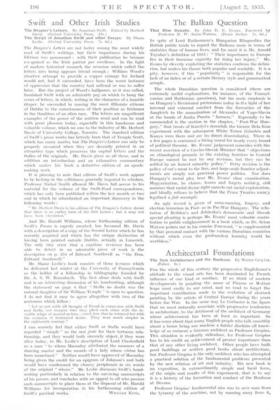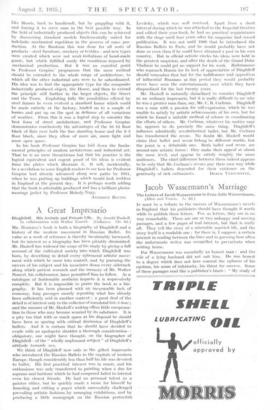Architectural Foundations • ,
Fort the whole of this century the progressive Englishman's attitude to the visual arts has been dominated by French influence of one kind or another. If we think of modern developments in painting the name of Picasso or Mitisse leaps most easily to our mind, and we tend to forget the important contribution made to the evolution of abstract painting by the artists of Central Europe during the years before the War. In. the same way Le Corbusier is the figure that we most naturally associate with progressive tendencies in architecture, to the detriment of the architect of Germany whose achievement has been at least as important. So it has come about that manyEnglish people who talk smoothly about a house being une machine a hailer disclaim all know- ledge of so eminent a German architect as Professor Gropius. This situation is evidently ridiculous, for Professor Gropius has to his credit an achievement of greater importance than that of any other living architect. Other people have built good buildings or written good books about architecture, but Professor Gropius is the only architect who has attempted a practical solution of the fundamental problems presented by the new relation of art and industry. His new book is an exposition, in extraordinarily simple and lucid form, of the origin and results of this experiment, that is to say it is a history of the formation and conduct of the Bauhaus at Dessau.
Professor Gropius' fundamental aim was to save man from the tyranny of the machine, not by running away from it, like Morris, back to handicraft, but by grappling with it, and forcing it to serve man in the best possible way. In the field of industrially produced objects this can be achieved by discovering standard models fundamentally suited for indefinite mechanical repetition in the process of mass pro- duction. At the Bauhaus this was done for all sorts of products—steel furniture, crockery or textiles—and new types were created which were not weak imitations of hand-made goods, but which fulfilled easily the conditions imposed by mechanical production. But it was an essential point in Professor Gropius' programme that the same method should be extended to the whole range of architecture, to Which all the other industrial arts were to be subordinated. His idea was to find the appropriate type for the composite industrially produced object, the House, and then to extend the principle still further to the larger objects, the Street and the Town. Exploiting fully the possibilities offered by steel frames he even evolved a standard house which could be made entirely at the factory, loaded on to a couple of lorries, and put up on the spot in defiance of all variations of weather. From this it was a logical step to consider the best form of street architecture, and Professor Gropius demonstrates conclusively the advantages of the 10--12 floor block of flats over both the free standing house and the 3--5 floor block, since they allow of more air, more light and more open space.
In his book Professor Gropius has laid down the funda- mental principles of modern architecture, and industrial art. That he is no mere theoretician but that his practice is the logical equivalent and ,cogent proof of his ideas is evident from the plates which illustrate it. It will, incidentally, be a revelation to some English readers to see how far Professor Gropius had already advanced along new paths by 1911, when he was putting up buildings which would look reckless in England at the present day. It is perhaps worth adding that the book is admirably produced and has a brilliant photo- montage jacket by Professor Moholy-Nagy. • ANTIIONY BLUNT.







































 Previous page
Previous page